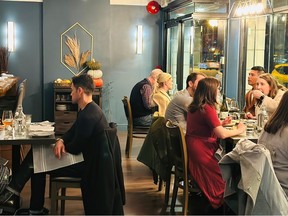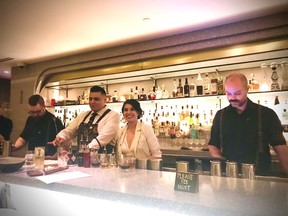Reviews and recommendations are unbiased and products are independently selected. Postmedia may earn an affiliate commission from purchases made through links on this page.
Trendspotting: Vancouver restaurants adapt to shifting landscape

50 per cent of restaurants are barely making it, and the coming year will be rough

Article content
Vancouver’s hospitality industry is evolving, responding to circumstances, be they economic, environmental, a pandemic, technological, or global.
Currently, the elephant stomping around the industry is the brutal fact that 50 per cent of restaurants are barely making it and the coming year will be rough, some not making it.
Article content
In the midst of that, I’ve done some trendspotting, and here are some, recently noted.
Advertisement 2
Article content
Sea Change
Robert Clark — once maestro of modernist cuisine at the ground-breaking C restaurant in his former cheffing days — sees a sea change forced by external circumstances, such as the economy.
“The hospitality industry’s going to look drastically different because of all the pressure on it,” says Clark, who, along with another veteran chef, Julian Bond, recently started up culinary consulting firm, Aramé.
“Vancouver’s going to have a more realistic balance. People fear change, but the status quo isn’t working. The days of running a restaurant where staff are poorly paid, the food is of poor quality, and it’s all about making money, is ending. The smart ones will provide value and a purpose — something more than serving food and making money.
“Restaurants have to know what they’re doing, how to treat staff and customers, and approach it like the John Bishops of the world, with true hospitality. (The now-closed Bishop’s restaurant) was authentic and it was rewarded for that. It just wanted to provide hospitality.”
Staffing shake-up, tipping, vegan food and natural wines
Advertisement 3
Article content
Folke vegan restaurant takes a kick at the status quo of which Clark speaks. In more ways than one.
It did away with the tipping system, paying staff a living wage, offering benefits and equalizing the front and back of house.
“We didn’t want that big divide between front and back,” says Colin Uyeda, chef and co-owner. Staff get dental and medical benefits, and there’s another fund for staff to spend on “for extras,” he says. “It can be for medical, or glasses, or to buy RRSPs, or to go golfing.”
It works because they’re a small, cohesive team “who care about hospitality and buy in to how we do things. There are no egos or riffs, he says.
“It’s also about stability for staff, getting rid of the biases that tipping can create, and to just providing an authentic experience.” He thinks the uptake will be glacial. “We’re starting from scratch and on a small scale. That’s all,” he says.
And Folke’s vegan food builds on the fast-growing demand for plant-based fare, but delivers it so tastefully (note the Michelin recommendation) so that even carnivores like my husband love going there. Folke’s drinks menu reflects another trend toward natural, low-intervention wines.
Article content
Advertisement 4
Article content
Tipping will be a big talking point as consumers feeling tipping fatigue resent shelling out at counters for little or no service.
“We have to be very clear,” says Ian Tostenson of the B.C. Restaurant and Foodservices Association. “At restaurants where you’ve had an enjoyable experience, tip 20 per cent, no question, but I don’t think tipping has a place at a counter. It’s an acknowledgement for going the extra mile.”
Zeitgeist
“I don’t necessarily follow trends per se,” says Gus Stieffenhofer-Brandson. “I’m not swayed.”
Although the food at his Michelin-starred Published on Main defies definition and is very much his own, it’s not completely free of a zeitgeist. It leans to progressive and translates into respectful cooking.
Respect for ingredients, our planet, our farmers, our producers and the influence of the Earth’s orbit around the Sun. It’s inspired by ingredients and magicked into unique, beautiful dishes.
Many like him are colouring outside the line — Andrea Carlson (Burdock), Justin Song-Ell (Elephant), Mike Robbins (AnnaLena), Jefferson Alvarez (Aquafarina), and others.
Advertisement 5
Article content
“Contemporary West Coast is my elevator pitch, but it’s really organized chaos,” Stieffenhofer-Brandson adds. “It’s organic. I build dishes to be eaten, layered, each with optimal bites. I’ve gotten away from elaborate platings, dots. I want it to look slick and polished, but simple,” he says, describing his one-of-a-kind dishes.
And like the trendsetting Noma restaurant, his menus embrace the wild and terroir — wild roses, wild greens, beach coriander, nettles, and not to forget the 300 pounds of elderflowers Stieffenhofer-Brandson turns into elderflower vinegar every spring.
He is respectfully learning to use sweetgrass, a plant sacred to First Nations people. And Noma-like, he has learned the science of fermentation, using misos, shoyus, koji, amazake and pickling to preserve and boost ingredients.
Collaborations, flight of business
Vancouver’s on the international stage, and far-flung chefs and bartenders are eager to collaborate with the talent here, and local diners are excited by the international zsa zsa zsu (to quote Carrie Bradshaw).
Advertisement 6
Article content
At Maenam Thai restaurant, for instance, I was thrilled to attend the restaurant’s dinner collab with rock star Thai chef David Thompson. In a couple of months, Maenam will be hosting chefs from the notable Bo.Lan restaurant in Thailand.
For chef Hector Laguna of Botanist, collaborations are a thank you to loyal customers.
“It’s pretty cool. It’s great to see that chefs and bartenders want to come and work with us,” he says.
The last collaboration was with the two-Michelin Lazy Bear chef who was awed by Vancouver’s bounty.
“I feel there’s so little awareness of how much we have here,” says Laguna.
Botanist collabs include many high-profile international bartenders, and the kitchen creates a menu to match the cocktails. More collaborations are planned for this year, Laguna says.

The too-cool Lao Wai cocktail lounge in Chinatown has done six bartender collaborations in the past year or so, with mixologists from China, Mexico, and Italy. There are four more in the offing, from Singapore, China, Argentina and Spain.
“We want to see what others are doing. Not everyone can get to China and Mexico, so we bring a little piece of travel home, especially when purse strings are tight,” says co-owner Lewis Hart, who also benefits from international exchanges.
Advertisement 7
Article content
He was recently hosted in Guangzhou to learn about baijiu, the 110-proof Chinese spirit that’s having its moment at Hart’s establishments.
“It’s value-added for customers,” he says, adding that guest bartenders often leave Vancouver scratching heads as to why the city hasn’t more swagger on the world stage given its talent.
Which leads us to a gloomy possibility for the future. Hart is actively looking to start a cocktail bar outside of B.C. and in another country, possibly London. Why?
“The red tape is almost non-existent in other places and the rewards are so much higher. Rents are cheaper, as is the cost of liquor and labour. The exchange rate and consumer price index are so much better. Our purchasing power here is at an all-time low,” he says. “In B.C., there’s a myriad of things working against you.”
Among them, is the B.C.’s liquor control and distribution laws and product availability. Zoom and other technology shrinks international business operations to a global village, he says.

Tasting menus, pre-paid dinners
Higher-end restaurants have been moving to pre-paid chef’s tasting menus, thanks in part to narcissistic no-show customers who make reservations, sometimes at several restaurants, and don’t bother with cancellations.
Advertisement 8
Article content
“It’s a solution to what’s happening in Vancouver,” says J.C. Poirier of the one-Michelin St. Lawrence restaurant. “For a small restaurant like ours with not many walk-ins, one or two no-show tables affect the business.”
St. Lawrence’s blind tasting menus, French, with Quebecois accents, streamlines efficiencies with inventory control and menu development.
The kitchen can pivot with product availability and use the best quality products. “The menu’s more playful and different every time and it’s fun for employees and guests. It’s like a brand new restaurant every time,” says Poirier. “There’ve been zero complaints from customers.”
Published, another Michelin star restaurant, and its sibling Bar Susu, are both able to offer stellar pre-paid chef’s tasting menu that way, too, but they also offer a la carte options with a deposit that is refundable up to 24 hours before the reservation. For events like concerts or a hockey game, you pay the whole shebang without the luxury of refunds. Taking deposits is a no-brainer trend that needs traction.
At Maenam, chef-owner Angus An feared switching to a set menu and when he finally did last year, his customers didn’t skip a beat. He runs a chef’s tasting menu in the dining room and a small a la carte menu for seats reserved for walk-ins.
Advertisement 9
Article content
“Deep down, I was scared of putting people off but it’s a testament to how far Vancouver’s come. When I opened Gastropod 17 years ago with a $38 tasting menu, people gasped,” he says. “Our cooks can now focus on quality and I’m able to streamline business. The thing is to provide good value and offer something they can’t get anywhere else.”
Technology and robots
We’re familiar with QR codes (thank you, pandemic), online ordering and deliveries, mobile apps, tablets for order taking, contactless payment systems, digital kitchen boards to track and send out orders. And there’s software to monitor inventory, schedule staff, and to gather customer intelligence — like whether they’re regulars, have allergies, what they like to eat, and maybe some personal talking points for servers.
So far, no driverless delivery cars roam our streets nor are there drones dropping food off for porch pirates to swoop in.
But there’ve been a few restaurant robots in Metro Vancouver replacing some aspects of service. Frankly, they look more like the offspring of a shelving unit and a Roomba than anything human, and useful for delivering menus and some food but I don’t expect they’ll be pouring wine or mingling with haute diners anytime soon.
Advertisement 10
Article content
Hao’s Lamb Restaurant in Richmond was the first to use a robot but it was decommissioned because space between tables got tight and they worried about it spilling hot lamb noodle soup on guests. Children, of course, loved the roaming glorified Roomba.
Retail
Retail broadens revenue sources at restaurants with frozen items from the menu, lifestyle products, groceries and other edibles.
For example, A.Bento and Birdies have freezer and cooler foods. Novella Coffee Bar, Collective Goods, Marché Mon Pitou, Batard Bakery Cafe, Casa Mia, Modern Pantry cafe, Tamaly Shop have specialty grocer sections. Kozak Ukrainian and Kozak Ukrainian Eatery and Mill restaurants sell enticing baked goods.
Two Rivers North Van is a restaurant/ butcher shop while their shop at Park Royal in West Van is more butcher shop with a few counter seats and small menu.
Recommended from Editorial
Bookmark our website and support our journalism: Don’t miss the news you need to know — add VancouverSun.com and TheProvince.com to your bookmarks and sign up for our newsletters here.
You can also support our journalism by becoming a digital subscriber: For just $14 a month, you can get unlimited access to The Vancouver Sun, The Province, National Post and 13 other Canadian news sites. Support us by subscribing today: The Vancouver Sun | The Province.
Article content
Source: vancouversun.com



